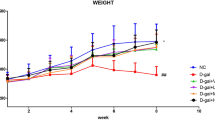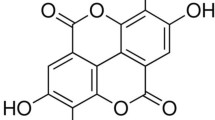Abstract
We successfully established an oxidant damageof mimetic aging model using mice induced byD-galactose, and the mimetic aging model isrelative to free radical and the accumulationof waste substances in metabolism. The animalswere divided into 3 groups: (1)phosphate-buffered saline (PBS); (2) 1%D-galactose; (3) 5% D-galactose bysubcutaneous injection every day. After 45days, mice treated with D-galactose showed asignificant increase in the malondialdehyde(MDA), total antioxidant status (TAS) and adecrease in superoxide dismutase (SOD) in the blood comparedwith the PBS group. In the brain, theD-galactose treated mice exhibited a higherlevel MDA and a lower level SOD activity.In the liver, only the 5% D-galactose groupindicated a significant increase in MDA. By reference to theoxidative biomarkers in blood, brain and liver,we have confirmed the reliability of themimetic aging model.
Similar content being viewed by others
References
Andersen HR, Nielsen YB, Nielsen F and Grandjean P (1997) Antioxidative enzyme activities in human erythrocytes. Clin Chem 43: 562–568
Arai K, Magushi S, Fujii S, Istribashi H, Oikawa K and Taniguchi N (1987) Glycation and inactivation of human Cu-Zn-superoxide dismutase. Identification of the in vitro glycated sites. J Biol Chem 262: 16969–16972
Balz F, Roland S and Bruce NA (1988) Antioxidant defenses and lipid peroxidation in human blood plasma. Proc Natl Acad Sci USA 85: 9748–9752
Beckman KB and Ames BN (1998) The free radical theory of aging matures. Physiol Rev 78: 547–581
Benedetti MS and Keane PE (1980) Differential changes in monoamine oxidase A and B activity in the aging rat brain. J Neurochem 35: 1026–1032
Brownlee M (1995) Advanced protein glycosylation in diabetes and aging. Annu Rev Med 46: 223–234
Chellan P and Nagaraj RH (2001) Early glycation products produce pentosidine cross-links on native proteins. J Biol Chem 276: 3895–3903
Finkel T and Holbrook NJ (2000) Oxidants, oxidative stress and the biology of aging. Nature 408: 239–247
Gong GQ and Xu FB (1991) Study of aging model in mice. J China Pharm Univ 22: 101–103
Grune T (2000) Oxidative stress, aging and the proteasomal system. Biogerontology 1: 31–40
Guo J, Zhao X and Liu G (1999) The effect of the juices of wild jujubi, haw thorn and grape on rat model induced with overdose of D-galactose. Acta Nutrimenta Sinica 21: 149–152
Harman D (1957) Aging: a theory based on free radical and radiation chemistry. J Gerontol 2: 298–300
Inal ME, Kanbak G and Sunal E (2001) Antioxidant enzyme activities and malondialdehyde levels related to aging. Clin Chim Acta 305: 75–80
Ingram DK and Jucker M (1999) Developing mouse models of aging: a consideration of strain differences in age-related behavioral and neural parameters. Neurobiol Aging 20: 137–145
Jucker M and Ingram DK (1997) Murine models of brain aging and age-related neurodegenerative diseases. Behav Brain Res 85: 1–25
Li G (2000a) Effects of polygala tenuifolia willd on SOD activity of RBC and GSH-Px activity of liver tissue in aging mouse caused by D-galactose. Heilongliang Med Pharm 23: 4–5
Li K (2000b) Effects of Xixin, Duzhong and their mixture on the activity of D-galactose-induced CAT senile mice. Heilongliang Med Pharm 23: 1–2
Li WB, Wei F and Fan M(1995) Mimetic brain aging effect induced by D-galactose in mice. Chin J Pharm Toxicol 9: 93–95
Liu H, Li B and Feng Y (2000) Effect of shenjian capsule on aging mice induced by D-galactose. Chin New Drugs J 9: 236–237
Rogina B and Helfand SL (2000) Cu, Zn superoxide dismutase deficiency accelerates the time course of an age-related marker in Drosophila melanogaster. Biogerontology 1: 163–169
Salo DC, Pacifini RE and Davies KJN (1988) Superoxide dismutase is preferentially degraded by a proteolytic stem from red blood cells following oxidative modification by hydrogen peroxide. Free Radic Biol Med 5: 335–339
Sevanian A and Ursini F (2000) Lipid peroxidation in membranes and low-density lipoproteins: similarities and differences. Free Radic Biol Med 29: 306–311
Singh R, Barden A, Mori T and Beilin L (2001) Advanced glycation end-products: a review. Diabetologia 44: 129–146
Song X, Bao M, Li D and Li YM (1999) Advanced glycation in D-galactose induced mouse aging model. Mech Aging Dev 108: 239–251
Stadtman ER (1992) Protein oxidation and aging. Science 257: 1220–1224
Vanfleteren JR (1993) Oxidative stress and ageing in Caenorhabditis elegans. Biochem J 292: 605–608
Wang S, Xie Q and Fu W (1999a) The effect of ginsenoside from stem and leaf on the D-galactose induced aging rat. J Chin Med Univ 28: 164–165
Wang Z (1999b) Physiologic and biochemical changes of mimetic aging induced by D-galactose in rats. Lab Anim Sci Admin 16: 23–25
Wittaker M.M and Wittaker JW (1988) The active site of galactose oxidase. J Biol Chem 263: 6074–6080
Xu FB (1985) Sub-acute toxicity of D-galactose. Proceedings of the Second National Conference on Aging Research. Herbin, China
Xu XH and Zhao TQ (2002) Effects of puerarin on D-galactosee-induced memory deficits in mice. Acta Pharmacol Sin 23: 587–590
Yang HY and Li JC (2000) Anti-aging action of melatonin on D-galactose model mice. Chin Pharmacol Bull 16: 397–400
Young S (1993) Against ageing. New Scientist 17: 10–12
Zuo S (1998) Effect of spirulina polysaccharide on the D-galactose induced aging model mice. Chin J Biochem Pharm 19: 15–18
Author information
Authors and Affiliations
Corresponding author
Rights and permissions
About this article
Cite this article
Ho, SC., Liu, JH. & Wu, RY. Establishment of the mimetic aging effect in mice caused by D-galactose. Biogerontology 4, 15–18 (2003). https://doi.org/10.1023/A:1022417102206
Issue Date:
DOI: https://doi.org/10.1023/A:1022417102206




